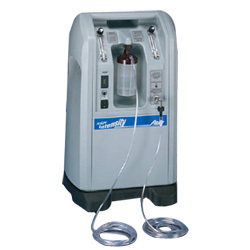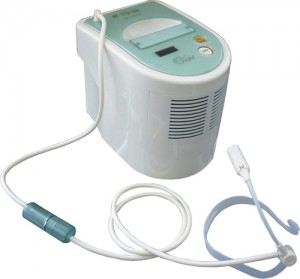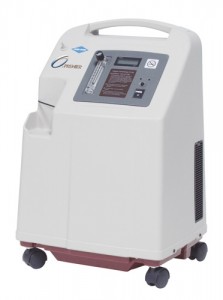Categories
How Does An Oxygen Concentrator Work?

Many people in the world suffer from chronic issues that impair their breathing, whether they struggle with COPD or lung cancer or another ailment. Trouble breathing can seriously impair many aspects of day to day life, and the majority of people would prefer to have more ease with breathing. Part of the problem usually stems from their body not getting enough oxygen from the air around them with each breath, resulting in numerous other health issues. An oxygen concentrator could be the solution people need to not only aid with the process of breathing currently but also prevent future issues that come from shortness of breath. This kind of advancement in medical technology is an amazing improvement for many, and it deserves recognition and understanding throughout the different communities associated with breathing difficulties.
Contents
What Is An Oxygen Concentrator?
An oxygen concentrator is an alternative solution to carrying around a cumbersome oxygen tank. This is especially good for individuals who strive to maintain independence and active lifestyles despite whatever physical impairment they have to deal with. Currently, there are two different types of oxygen concentrators available to aid the lifestyles of the breathing impaired.
Type One: Home
A home device is typically used within the home environment because it is dependent upon a consistent power source, like an electrical outlet. The design of the device makes it mobile up to a point—it is easily transported throughout the house, but it is necessarily heavier than would be appropriate for extensive travel. They usually come with casters, which help individuals cart the concentrators from room to room with more ease. The home oxygen concentrators can be anywhere from 30 to 55 pounds, and they are more restricting than their counterparts. The concentrator is capable of being moved directly outside, but it requires a longer tube supply than is usually found with the device. What people typically value in their home oxygen concentrators is not only easy of mobility but also noise level. Many concentrators are actually quite loud, and the majority of individuals who suffer from breathing-based ailments would prefer to have a quieter, light weight model in their homes.
Type Two: Mobile
The secondary, though infinitely more popular, type of oxygen concentrator would be the ones that individuals can readily take with them on any excursion. With a significantly more sleek design, a lighter weight, and a multitude of power-oriented options, the mobile models tend to be incredibly well-liked in the community. They can be plugged into wall outlets just like the home models, but they also have a battery life that allows them to be maneuvered around for quite some time without issue. Even more impressive would be the fact that individuals can take their mobile oxygen concentrators and charge them with the cigarette lighter in the car, much like a cell phone charger. They can also be taken on any public transportation, like trains, cruise ships, buses, and the like. This makes them incredibly popular, and many people benefit greatly from the usage of portable oxygen concentrators.

How Do They Differ From Oxygen Tanks?
While oxygen tanks offer a steadfast solution for people suffering from breathing troubles due to illnesses like some forms of cancer, they can be incredibly difficult to work with. The tank itself is usually unfortunately heavy and comes with a transportation aid, often bearing resemblance to a wheeled suitcase. The oxygen is stored under pressure in gas cylinders and is typically distributed to the individual in need through an oxygen mask, a nasal cannula, or a rebreather. There is a necessity for all equipment that comes into contact with the oxygen tank to be oxygen clean, which is a term indicating the minimization of risk of fire from combustion at high temperatures. This can also be a struggle for people who need to use oxygen tanks frequently.
An oxygen concentrator, on the other hand, provides an entirely different experience for the user. The oxygen concentrator is incredibly similar to an air conditioning unit, in that it takes in the existing air and alters it before redistribution. The air, instead of being cooled or heated accordingly, is miraculously transformed into medical grade oxygen. The air is pulled in to the system and subsequently filtered, wherein the oxygen is compressed. Additionally, the air flows through at least two more chambers within the concentrator in order to completely remove all traces of other air components from the oxygen concentration. Nitrogen is a primary gaseous substance that must be removed from the air, and this is the focus of the following chambers. A filter, sieve beds, and a few other devices are commonly used to achieve this goal. The oxygen, after it has been purified to a medical grade, is transported up through a flowmeter and nasal cannula. Occasionally, individuals will have to use a mask instead, because of their own circumstantial issues.
How Is The Oxygen Delivered?
A Steady Supply
The most important part of making sure the oxygen delivery process is effective, efficient, and appropriate is by ascertaining that the device is plugged in to a source. Depending on the type of device, that needs to either be a wall electrical outlet, a lithium battery, or a cigarette lighter. This will prevent any mishaps from occurring.
Use of the Cannula
A nasal cannula is the most common method of oxygen distribution for individuals in need. It is fitted directly under the nostrils and is supported by plastic tubing that loops around the ears, similar to glasses holders. Making sure the cannula is appropriately placed is imperative to oxygen therapy. With an oxygen concentrator used in conjunction with a nasal cannula, the individual will breath in the surrounding air in addition to the medical grade oxygen. The oxygen is subsequently diluted, but this is still much more effective for the disabled than breathing in the typical fashion.
Prospective Oxygen Masks
Depending on the circumstance of the specific person, an oxygen mask may be a more viable option. If an individual requires a purer form of oxygen, or a higher concentration of oxygen at a regular rate, then the mask is probably their best option. Though it is typically regarded as immensely more uncomfortable than the cannula, the oxygen mask provides a flow of air that is less diluted and more direct. Because the mask covers the mouth in addition to the nostrils, it offers wider access to a higher amount of oxygen.

What Do The Experts Think?
The talented individuals at COPD Foundation have stated that the main issue people tend to have with the continual flow oxygen concentrators is that they are larger in size due to their production capacity. These models are rather bulky, though they are light weight, and this is due to the sieve bed.
COPD Foundation also expressed that the best way to determine if your lungs are being appropriately and properly saturated by whatever specific unit you are working with is to use a pulse oximeter. This should be checked both during rest and during exertion in order to get the most accurate reading, and it should be done by a medical professional.
The American Association for Respiratory Care has said that the majority of individuals at their organization believe that increased activity levels in conjunction with supplemental oxygen as needed can seriously minimize the expenditures associated with chronic pulmonary disease exacerbations.
The COPD Foundation declared that portable oxygen concentrators are not “one size fits all” for people with different issues, and no one should feel uncomfortable about returning a unit that does not work right for them.
George Gaebler of the AARC commented on the publishing of a guide for oxygen concentrators by saying, “The information on the performance and characteristics of each POC will be a valuable reference to clinicians as well.” Now that a guide has been provided for both individuals suffering from breathing issues as well as medical personnel in the field, less problems will be associated with the ordering of such devices.
As one of the most important advances in medical science and technology to this day, the oxygen concentrator is capable of providing a more well-rounded life for individuals plagued by breathing conundrums. COPD, lung cancer, and other respiratory illnesses can be life-changing enough without being detrimental to the future breathing prospects of an individual. With the improved portability, efficiency, and accessibility to oxygen concentrators, people are able to live their lives in a more fulfilling and exciting manner. The travel opportunities that come along with the use of a portable oxygen concentrator, the home-oriented mobility and independence that comes with the use of a home oxygen concentrator, and the freeing ability to take care of oneself without the restrictions associated with a regular oxygen tank are more than enough to convince anyone of the impressive nature of oxygen concentrators. The future of assisted breathing and oxygen therapy lies within the realm of these fascinating machines, which provide countless opportunities for personal improvement.



